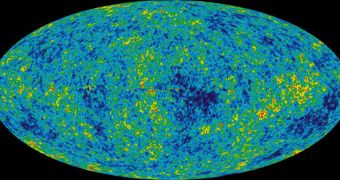The most widely-accepted model of how the Cosmos is set up shows us that only about 4 percent of the Universe's mass-energy budget is made up of normal matter. This includes all the stars, galaxies, clusters, superclusters, supernovae and black holes you can think of. Asteroids, comets, and all other space rocks also fall into this category, astronomers say. The remaining budget should be made up of dark matter (22 percent) and dark energy (74 percent). But new studies seem to indicate that the two advanced concepts are not necessary for explaining the way the Cosmos moves and evolves.
One of the main reasons for which dark matter is needed in theory is because there appears to be no other means of accounting for why galaxies stick together. According to astrophysicists, without dark matter, there would be absolutely nothing keeping galaxies in check. Dark matter therefore acts through the force of gravity, which it exerts on regular matter around. Detectors built to find particles generated by this type of matter have thus far failed to turn up any positive findings, although considerable time and effort went into this, Space reports.
Dark energy, on the other hand, is another story completely. Astronomers need it to exist in order to account for the expansion of the Universe. Since the Big Bang, everything around us has been moving away from the initial site of the blast, at ever-increasing speed. This is impossible under normal theories, and so experts had to come up with dark energy. Details on dark matter and dark energy are usually derived from readings of the Cosmic Microwave Background (CMB), the afterglow left behind after the Big Bang. The Wilkinson Microwave Anisotropy Probe (WMAP) is the most well-suited spacecraft in the world for CMB analysis, and as such was also used for the new investigations.
“It's such an important thing – the microwave background. All the results in dark energy and dark matter in cosmology hang on it, and that's why I'm interested in checking the results,” explains Durham University astrophysics expert Tom Shanks. He explains that his team found a lot less variations in the CMB, after they used a very distant object to fine-tune the WAMP. Generally, the spacecraft is calibrated using Jupiter as a reference point. “When we checked radio sources in the WMAP background, we found more smoothing than the WMAP team expected. That would have big implications for cosmology if we were proven right,” the scientist says.
If the variations in the CMB are more reduced than first calculated, then the existence of dark matter and dark energy is no longer needed to explain the Universe. But while not many scientists agree with the new theory, the team says that there is a large chance of getting confirmation of their suspicions. “I'm very interested to see what [the European Space Agency's new] Planck [telescope] gets in terms of its results. And of course we will be there to try and keep everybody as honest as possible. We're hoping we can use our methods in the same way to check their beam profile that they ultimately come up with,” Shanks says. Details of the investigation will appear in an upcoming issue of the esteemed journal Monthly Notices of the Royal Astronomical Society.

 14 DAY TRIAL //
14 DAY TRIAL //